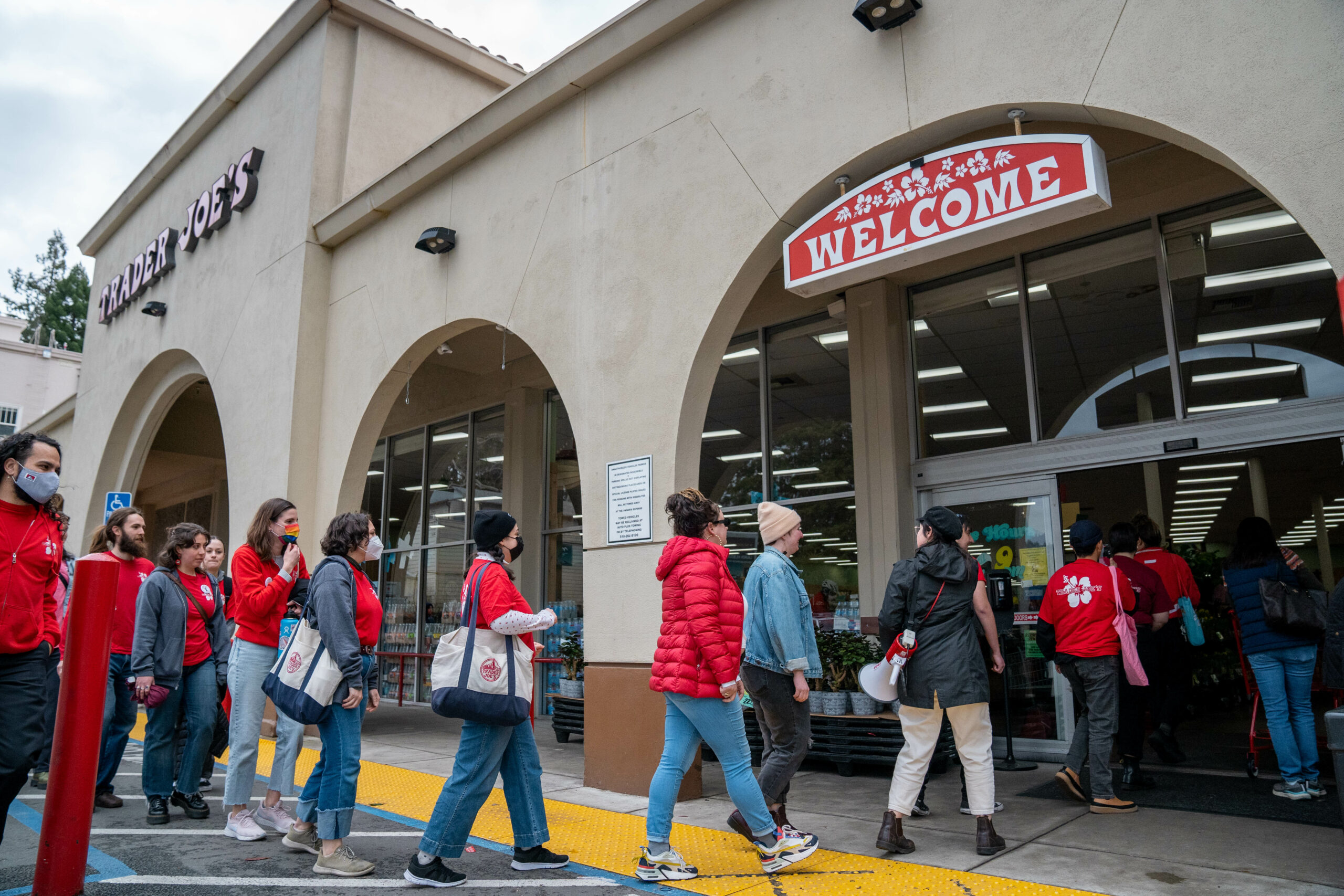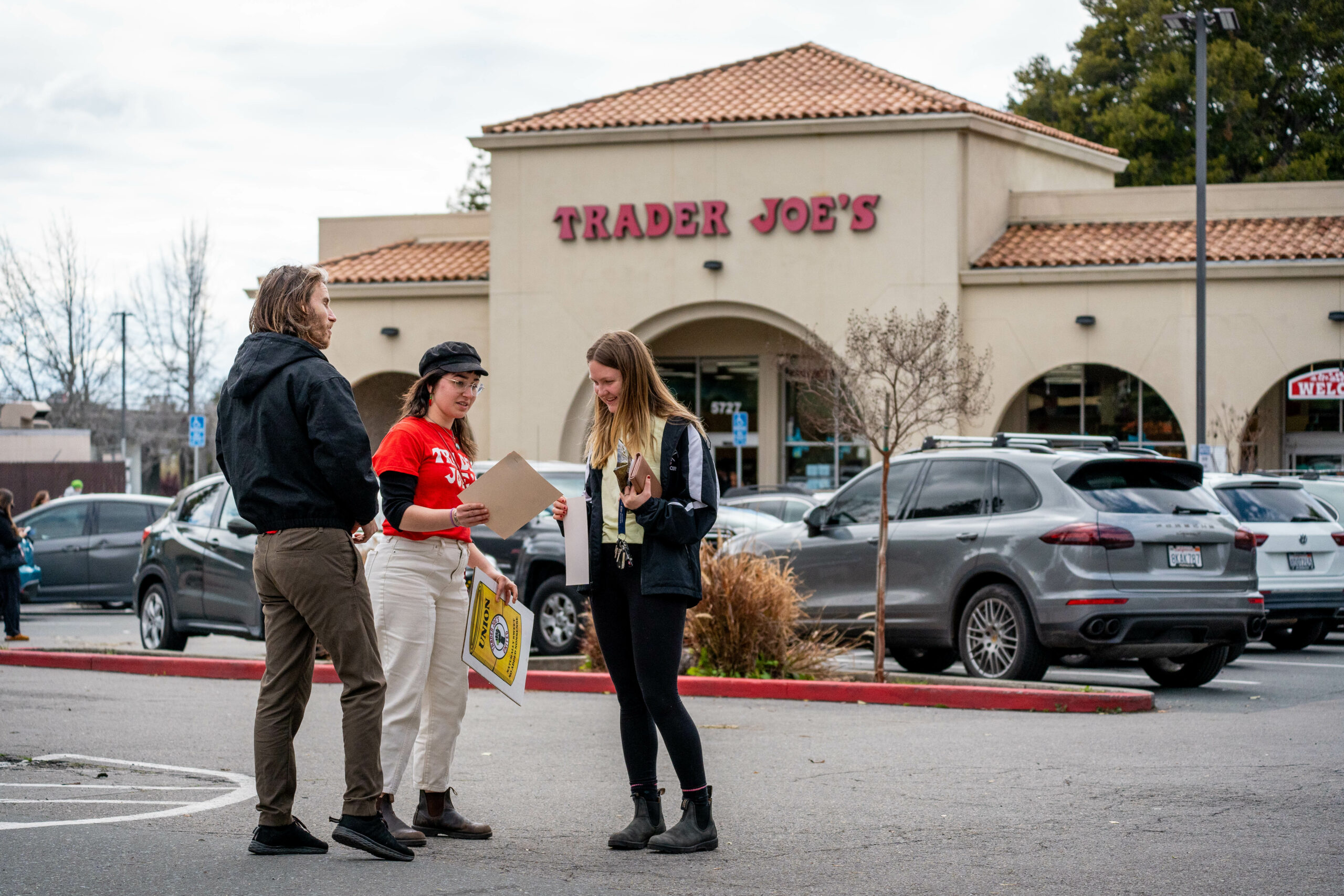
On a cloudy afternoon in March, two dozen Trader Joe’s employees filed into the bustling Oakland store in the Rockridge neighborhood. They marched past displays of potted Phalaenopsis orchids, stacks of grapefruit sparkling water and knotty pine checkout counters, then gathered in a corner near shelves of Charles Shaw cabernet sauvignon. Kaitlyn Custer, a six-year employee of the company, approached the Hawaiian-shirt-clad store manager — “captain” in Trader Joe’s nautical lingo — with a sheet of paper in her hand.
“We are writing to inform you of our intent to organize,” Custer read from a prepared statement, followed by whoops and cheers from coworkers. The captain looked perplexed. Custer explained that they were seeking to join a union, Trader Joe’s United (TJU). Message delivered, the delegation headed back outside to pass out flyers and buttons to customers.

One month later, the store workers voted 73-53 to join the union. The election made the Oakland store the fourth Trader Joe’s to unionize since July 2022, joining stores in Minnesota, Kentucky and Massachusetts. And while the union lost elections in Manhattan and Brooklyn — the former to a tie — organizers say they’ve fielded inquiries from stores in all 42 states (along with Washington, D.C.) in which the company operates.
As organizing has spread, the company known for its friendly staff has been hostile to its workers’ efforts to demand a union, say activists.
Trader Joe’s did not respond to repeated requests for comment.
“They have delivered threats, told people they wouldn’t get raises if they unionized, just lie after lie,” said Maeg Yosef, the communications director for TJU, who has worked at the store in Hadley, Massachusetts, since 2004. Despite its progressive and folksy reputation, Yosef said, Trader Joe’s “has rolled out the sort of union-busting campaign you might see at Amazon or Starbucks.”
Trader Joe’s workers first began organizing their own union in 2022. They were partly inspired, they say, by the growing wave of union organizing at once-unlikely companies like Starbucks, Apple and REI. But they were also inspired by the divide between Trader Joe’s image and the way they say they were treated when customers were out of earshot.
“Working at Trader Joe’s is physically and emotionally strenuous,” Custer told Capital & Main. “They ask the crew to provide a ‘wow’ customer experience, but there is this cognitive dissonance of them asking us to be super friendly-faced while treating us differently behind closed doors.”
Workers say the company has also added injury to that insult. Half a dozen workers across the four union Trader Joe’s cited common complaints that spurred organizing, including safety concerns. The rate of workplace injury among supermarket workers is 75% higher than the national average, and multiple workers said they had suffered repetitive stress and back injuries at work.
Yet according to the New York Times and workers interviewed by Capital & Main, the company has pared back its health coverage and cut retirement contributions. About a decade ago, healthcare kicked in once an employee averaged about 20 hours of work a week and the company offered retirement contributions of 15% of a worker’s earnings. Today, the threshold to qualify for healthcare is 28 hours a week and the company no longer offers a set contribution to retirement. Workers also say that wage rates now vary so widely that longtime employees can earn less than new hires. “Little by little, there was this erosion, and I began to experience more and more disillusionment with the company,” said Dominique Bernardo, who has worked at Oakland’s Rockridge store for 18 years.
Organizing Trader Joe’s could provide a corrective to the last four decades of plummeting union membership among supermarket workers, says Ruth Milkman, a labor sociologist at City University of New York who has studied the grocery industry. In 1983, one-third of grocery workers were unionized, the vast majority under the United Food and Commercial Workers. Today, unionization rates among supermarket workers are half that.
Much of the shift, says Milkman, reflects the introduction of new, non-union supermarkets that have rapidly gained market share: Walmart and Target at the scale of big-box stores; Whole Foods and Trader Joe’s at the neighborhood grocery level. “If Trader Joe’s were organized on a large scale, that would help to reverse the trend [of declining union density],” said Milkman.

Since June 2022, Trader Joe’s United has filed 48 charges of unfair labor practices that remain open with the National Labor Relations Board (NLRB), which range from firing union supporters to failing to bargain in good faith. These types of allegations, referred to as ULPs, are investigated by NLRB staff, who gather evidence and interview witnesses. If they find sufficient evidence to support the charge and the employer refuses to settle, the agency issues a formal complaint against the company that is heard before an administrative judge.
Trader Joe’s United has filed ULPs at all four union stores. That includes one filed in early September alleging the company had disciplined Bernardo, the longtime Rockridge employee, because she is a union activist.
Thus far, the NLRB has issued complaints against the company at union shops in Massachusetts and Minnesota. In Hadley, the agency cited the Trader Joe’s store for violations including illegally retaliating against and interrogating workers, threatening to freeze wages if workers unionized and suggesting their benefits could be taken away. In Minneapolis, the NLRB issued a complaint against the company for removing union materials from the break room. Separate hearings for each case are scheduled for October in front of NLRB judges. In Louisville, Kentucky, Trader Joe’s challenged the election results, citing six objections; the NLRB sided with the union in all six. (Trader Joe’s has appealed the decision.)
All of this, says Nelson Lichtenstein, a labor historian at the University of California, Santa Barbara, bears a noticeable resemblance to another name-brand store facing a wave of organizing workers: Starbucks. “They are absolutely the same,” Lichtenstein said. “They will use anything to break a union.” Indeed, during the initial union drive at Trader Joe’s, the company employed Littler Mendelson — the same law firm used by Starbucks to battle unions. Last year, the company switched to Morgan Lewis — the same firm used by Amazon. Both firms specialize in what is called the “union avoidance” industry.
In winning the four elections, Trader Joe’s United has had unusual success as an independent union staffed by workers without assistance from trained organizers at a long-standing union. But TJU has yet to achieve the ultimate goal: the signing of a contract that would transform workers’ aspirations into consistent wages, benefits and working conditions. This is a status shared by many other workplaces that have voted for a union. That includes the more than 350 stores that have unionized since 2021 with Starbucks Workers United, which has received support from the Service Employees International Union.
At Trader Joe’s, organizers say negotiations have stalled because the company is refusing to use “hybrid bargaining.” The NLRB ruled last March that Starbucks needed to allow that model, which permits negotiations to take place with a mix of remote and in-person attendees. In April, TJU filed a charge of unfair labor practice with the NLRB, seeking use of hybrid bargaining, but the agency has yet to issue a decision.

Late this summer, Trader Joe’s United filed a new kind of complaint. Under an August 25 NLRB decision involving Cemex Construction Materials Pacific and the Teamsters, the board held that companies found to have committed unfair labor violations during the run-up to an election must immediately recognize and bargain with the union. (Previously, the rule was to hold another election, requiring unions to start over from scratch.) The decision also applies retroactively to pending cases.
Four days after the Cemex decision was issued, TJU filed a request with the NLRB to force Trader Joe’s to recognize the union in the Manhattan store where the vote was tied. The union has two outstanding unfair labor practice charges at that store, including making coercive threats against union supporters.
Still, TJU isn’t waiting on the federal agency. The union says there are active organizing drives in about a dozen shops. “Most of us had zero previous organizing experience,” said Sarah Beth Ryther, a worker at the Minneapolis store who’s also the union’s vice president. “We’re not going anywhere.”
Copyright Capital & Main 2023